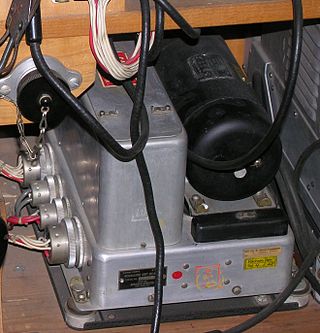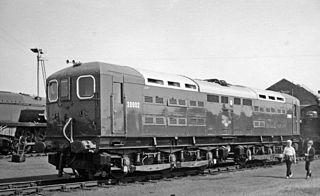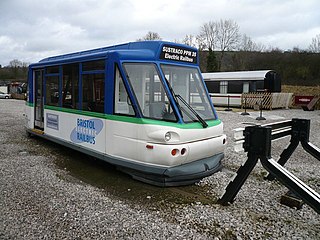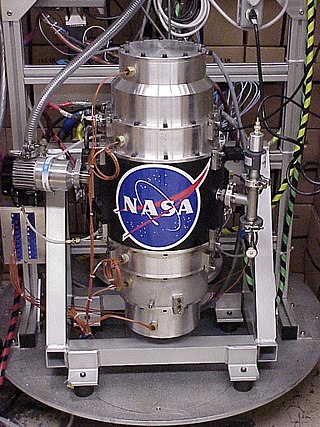
Energy storage is the capture of energy produced at one time for use at a later time to reduce imbalances between energy demand and energy production. A device that stores energy is generally called an accumulator or battery. Energy comes in multiple forms including radiation, chemical, gravitational potential, electrical potential, electricity, elevated temperature, latent heat and kinetic. Energy storage involves converting energy from forms that are difficult to store to more conveniently or economically storable forms.

A flywheel is a mechanical device which uses the conservation of angular momentum to store rotational energy; a form of kinetic energy proportional to the product of its moment of inertia and the square of its rotational speed. In particular, assuming the flywheel's moment of inertia is constant then the stored (rotational) energy is directly associated with the square of its rotational speed.

ABB Ltd. is a Swedish-Swiss multinational corporation headquartered in Västerås, Sweden, and Zürich, Switzerland. The company was formed in 1988 when Sweden's Allmänna Svenska Elektriska Aktiebolaget (Asea) and Switzerland's Brown, Boveri & Cie merged to create Asea Brown Boveri, later simplified to the initials ABB. Both companies were established in the late 1800s and were major electrical equipment manufacturers, a business that ABB remains active in today. The company has also since expanded to robotics and automation technology.
Distributed generation, also distributed energy, on-site generation (OSG), or district/decentralized energy, is electrical generation and storage performed by a variety of small, grid-connected or distribution system-connected devices referred to as distributed energy resources (DER).

Regenerative braking is an energy recovery mechanism that slows down a moving vehicle or object by converting its kinetic energy into a form that can be either used immediately or stored until needed. In this mechanism, the electric traction motor uses the vehicle's momentum to recover energy that would otherwise be lost to the brake discs as heat. This method contrasts with conventional braking systems. In those systems, the excess kinetic energy is converted to unwanted and wasted heat due to friction in the brakes, or with rheostatic brakes, where the energy is recovered by using electric motors as generators but is immediately dissipated as heat in resistors. In addition to improving the overall efficiency of the vehicle, regeneration can significantly extend the life of the braking system as the mechanical parts will not wear out quickly.

Dynamic braking is the use of an electric traction motor as a generator when slowing a vehicle such as an electric or diesel-electric locomotive. It is termed "rheostatic" if the generated electrical power is dissipated as heat in brake grid resistors, and "regenerative" if the power is returned to the supply line. Dynamic braking reduces wear on friction-based braking components, and regeneration lowers net energy consumption. Dynamic braking may also be used on railcars with multiple units, light rail vehicles, electric trams, trolleybuses, and electric and hybrid electric automobiles.

A motor–generator is a device for converting electrical power to another form. Motor–generator sets are used to convert frequency, voltage, or phase of power. They may also be used to isolate electrical loads from the electrical power supply line. Large motor–generators were widely used to convert industrial amounts of power while smaller motor–generators were used to convert battery power to higher DC voltages.

Grid energy storage is a collection of methods used for energy storage on a large scale within an electrical power grid. Electrical energy is stored during times when electricity is plentiful and inexpensive or when demand is low, and later returned to the grid when demand is high, and electricity prices tend to be higher.

The British Rail Class 70 was a class of three third rail Co-Co electric locomotives. The initial two were built by the Southern Railway (SR) at Ashford Works in 1940–41 and 1945 and were numbered CC1 and CC2 - the Southern Railway latterly preferring French practice for locomotive numbers which also gave an indication of the wheel arrangement. Electrical equipment was designed by Alfred Raworth and the body and bogies by Oliver Bulleid. CC2 was modified slightly from the original design by C. M. Cock who had succeeded Raworth as Electrical Engineer. The third was built by British Railways in 1948 and numbered 20003.

Microgeneration is the small-scale production of heat or electric power from a "low carbon source," as an alternative or supplement to traditional centralized grid-connected power.

Parry People Movers Ltd. (PPM) is a British company manufacturing lightweight trams and railcars that use flywheel energy storage (FES) to store energy for traction, allowing electric systems to operate without overhead wires or third rails, and railcars fuelled by small gas, diesel or hydrogen engines.
Hybrid vehicle drivetrains transmit power to the driving wheels for hybrid vehicles. A hybrid vehicle has multiple forms of motive power.
A hybrid train is a locomotive, railcar or train that uses an onboard rechargeable energy storage system (RESS), placed between the power source and the traction transmission system connected to the wheels. Since most diesel locomotives are diesel-electric, they have all the components of a series hybrid transmission except the storage battery, making this a relatively simple prospect.

A smart grid is an electrical grid which includes a variety of operation and energy measures including:

British Rail Class 139 is the TOPS classification for PPM60 model lightweight railcars built by Parry People Movers, for use on the British rail network. The class were originally built in 2008 for operation on the Stourbridge Town branch line following an extensive trial with a prototype registered as a Class 999 unit.

A kinetic energy recovery system (KERS) is an automotive system for recovering a moving vehicle's kinetic energy under braking. The recovered energy is stored in a reservoir for later use under acceleration. Examples include complex high end systems such as the Zytek, Flybrid, Torotrak and Xtrac used in Formula One racing and simple, easily manufactured and integrated differential based systems such as the Cambridge Passenger/Commercial Vehicle Kinetic Energy Recovery System (CPC-KERS).

An electrical grid is an interconnected network for electricity delivery from producers to consumers. Electrical grids vary in size and can cover whole countries or continents. It consists of:

Flywheel energy storage (FES) works by accelerating a rotor (flywheel) to a very high speed and maintaining the energy in the system as rotational energy. When energy is extracted from the system, the flywheel's rotational speed is reduced as a consequence of the principle of conservation of energy; adding energy to the system correspondingly results in an increase in the speed of the flywheel.

Home energy storage devices store electricity locally, for later consumption. Electrochemical energy storage products, also known as "Battery Energy Storage System", at their heart are rechargeable batteries, typically based on lithium-ion or lead-acid controlled by computer with intelligent software to handle charging and discharging cycles. Companies are also developing smaller flow battery technology for home use. As a local energy storage technologies for home use, they are smaller relatives of battery-based grid energy storage and support the concept of distributed generation. When paired with on-site generation, they can virtually eliminate blackouts in an off-the-grid lifestyle.

Skeleton Technologies is an energy storage developer and manufacturer for transportation, grid, automotive, and industrial applications. Skeleton uses a patented raw material, curved graphene, to produce solutions for the energy storage market, including high-power supercapacitors and high-energy solid-state batteries.

















